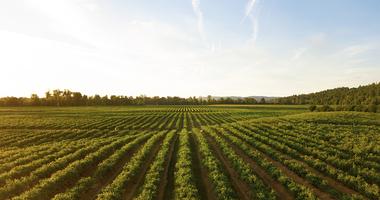
You Say You Want a Regenerative Future – So Do American Farmers
Funding in the IRA and proposed 2024 Farm Bill highlights the divide over priorities related to climate mitigation, adaptation, and resilience.
6 min read
By Nick Beck, Regenerative Agriculture Organizer
The historic $19.5 billion investment in climate-smart agricultural practices in the Inflation Reduction Act (IRA) represents a serious commitment by the United States Department of Agriculture (USDA) to a better, more sustainable future – with the IRA climate-smart agriculture funding already benefiting all 50 states.
But is this investment enough to prepare farmers for the impacts of climate change?
That depends on who you ask. To answer this question, you can compare current levels of funding to the overwhelming demand for conservation funding by farmers themselves.
And here’s what we are seeing: The IRA investment gave a necessary boost to existing programs and proved investments of this size are achievable. Unfortunately, it is not enough to meet the current demand for regenerative agriculture practices.
Understanding USDA Conservation & the IRA
The Environmental Quality Incentives Program (EQIP) and the Conservation Stewardship Programs are the flagship programs of USDA’s Natural Resource Conservation Services (NRCS). These programs follow a simple philosophy: helping producers make conservation work for them.
Through direct incentives and no-cost technical assistance programs, NRCS offers personalized advice and information based on the latest science and research to help farmers make informed decisions about their land. Many of the NRCS approved climate-smart mitigation activities are described as nature-based solutions.
EQIP funding helps agricultural producers and forest landowners address natural resource concerns, including air and water quality, soil health, wildlife habitat, and resilience to climate shocks. Specific practices that would be considered regenerative include low or no-tillage or conservation tillage, cover crops, perennial crops, and increased cropping systems diversity.
NRCS works one-on-one with producers to develop individualized conservation plans that lead to cleaner water and air, healthier soil, better wildlife habitat, lower input costs, improved yield and quality, and increased drought resistance, all while addressing specific barriers to their agricultural operations.
EQIP and CSP have traditionally been funded through the Farm Bill. Historically, there has always been a higher demand for these programs than funding could provide. But in August 2022, the IRA was signed into law, providing billions in funding for voluntary agriculture conservation programs.
Under the IRA, EQIP will receive $8.45 billion and CSP $3.25 billion, beginning in 2023 and lasting through 2026.
Several other programs within USDA’s conservation umbrella restore landscapes but do not constitute regenerative agriculture.
The Conservation Reserve Program (CRP) and easement programs allow farmers to remove environmentally sensitive land from agricultural production by leasing it to the USDA for 10-15 years of remediation.
A review of EQIP performance from recent years shows that the demand for EQIP funding and incentives consistently exceeds the available allocations, regardless of changes in funding levels. The Inflation Reduction Act (IRA) allocated $19.5 billion to NRCS for climate-smart agricultural programs, marking a historic investment at a crucial moment. Thus far, the interest in these programs has already far exceeded the available funding, including the influx of funding from the IRA.
While securing nearly $20 billion in conservation funding was a vital step toward a sustainable farming future, we remain in a similar position as before: available conservation funding is still insufficient to adequately cover the farmers' demands.
Farm Bill 2024 & USDA Conservation Programs
Farm funding in the IRA highlights the divide over priorities related to climate mitigation, adaptation, and resilience.
The 2024 US House of Representatives Farm Bill draft released in mid-May confirms some representatives’ priorities by allocating about $50 billion to increase subsidy reference prices for covered commodity crops. The authoring representatives argue that the investment ensures market stability, but this prioritization heavily favors major agribusinesses, leaving requests from small farm owners for accessible conservation funding unanswered.
According to the Environmental Working Group (EWG), the increased price guarantees would primarily benefit fewer than 6,000 farms concentrated in a few states. The Department of Agriculture estimates there are approximately 2 million farms in the US, meaning that raising reference prices would benefit less than 0.3% of all farms.
Smallholder and beginning farmers already face disparities in federal agriculture policy; they operate at too small a scale to fully benefit from crop insurance and safety net programs. This discrepancy has motivated environmental groups to advocate for the equitable distribution of crop insurance funding, given that regenerative and climate-smart practices significantly reduce the likelihood of crop loss from severe weather events like droughts.
Since 2021, USDA’s Risk Management Agency (RMA) invested $13 million in risk management education for underserved and small-scale producers, as well as other producers interested in organic and climate-smart farm practices. In fiscal year ‘23, 40% of EQIP funding and 22% of CSP funding went to historically underserved farmers across all states and territories, including veterans, farmers of color, and beginning farmers, ensuring equitable access to resources.
While the trend toward USDA advisory and technical assistance is beneficial, it should supplement, not replace, direct incentives.
Although the remaining IRA allotment is not at risk of significant cuts, the 2024 Farm Bill, in its current form, redefines eligibility for funding. This reclassification significantly diminishes the impact of the funding on climate resilience, adaptation, and mitigation.
Among the most contentious battles during the Farm Bill markup was the discussion of climate-smart legislative “guardrails.” The current House Farm Bill would remove these guardrails, opening EQIP and IRA funding to conservation practices beyond NRCS-approved methods.
Without the guardrails, we return to pre-IRA standards, where only one-fifth of conservation funding supported practices that reduced greenhouse gas emissions.
Some representatives have pointed to the extremely oversubscribed nature of conservation funding and argue that now is not the time to make this funding more flexible. While others argue that the guardrails are overly restrictive and exclude non-climate-friendly practices and should be decided by the states.
An amendment was introduced to reinstate the guardrails into the House Farm Bill. Unfortunately, the amendment did not pass.
The committee vote for final passage of the Farm Bill was successful, moving the House bill out of committee and onto the House floor, where it will be put to a general vote – and likely fail.
What You Can Do
All of which is to say, there is still time to raise your voice and support climate-smart, regenerative farming practices in the 2024 Farm Bill. It’s critical that Congress pass a 2024 Farm Bill – a once-every-five years piece of legislation – that includes the climate-smart tools and resources needed to reduce the impacts of climate change and incorporate sustainable conservation practices on farms.
The Farm Bill is a great opportunity to address the challenges farmers face while charting a course to a more resilient farm economy and food system.
You can also contact your elected officials’ offices by calling the US Capitol Switchboard at (202) 224-3121 and asking the operator to connect you directly with the office of the US representative you request.
While you may not speak directly with the official, their staff tracks the number of calls they receive – and it is a useful way to communicate your concerns, especially when a vote (like that on the 2024 Farm Bill) is pending.
If you want to learn more about how conservation dollars are being spent in your state, detailed investments are tracked by: NRCS, Protect Ag Conservation, and EWG.




